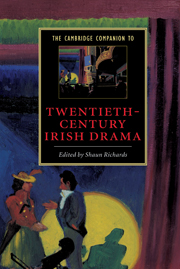Book contents
- Frontmatter
- 1 Plays of (ever) changing Ireland
- 2 Late nineteenth-century Irish theatre: before the Abbey – and beyond
- 3 The ideology of the Abbey Theatre
- 4 The theatre of William Butler Yeats
- 5 Lady Gregory’s Abbey Theatre drama: Ireland real and ideal
- 6 J. M. Synge, ‘national’ drama and the post-Protestant imagination
- 7 On the siting of doors and windows: aesthetics, ideology and Irish stage design
- 8 Oscar Wilde and the politics of style
- 9 George Bernard Shaw and Ireland
- 10 Sean O’Casey’s Dublin Trilogy: disillusionment to delusion
- 11 Ireland’s ‘exiled’ women playwrights: Teresa Deevy and Marina Carr
- 12 Samuel Beckett and the countertradition
- 13 Brian Friel’s sense of place
- 14 The Field Day Theatre Company
- 15 Tom Murphy and the children of loss
- 16 Reconstructing history in the Irish history play
- 17 The Abbey Theatre and the Irish state
- 18 Staging contemporary Ireland
- 19 The Revival revised
- Guide to further reading
- Index
- Series List
4 - The theatre of William Butler Yeats
Published online by Cambridge University Press: 28 May 2006
- Frontmatter
- 1 Plays of (ever) changing Ireland
- 2 Late nineteenth-century Irish theatre: before the Abbey – and beyond
- 3 The ideology of the Abbey Theatre
- 4 The theatre of William Butler Yeats
- 5 Lady Gregory’s Abbey Theatre drama: Ireland real and ideal
- 6 J. M. Synge, ‘national’ drama and the post-Protestant imagination
- 7 On the siting of doors and windows: aesthetics, ideology and Irish stage design
- 8 Oscar Wilde and the politics of style
- 9 George Bernard Shaw and Ireland
- 10 Sean O’Casey’s Dublin Trilogy: disillusionment to delusion
- 11 Ireland’s ‘exiled’ women playwrights: Teresa Deevy and Marina Carr
- 12 Samuel Beckett and the countertradition
- 13 Brian Friel’s sense of place
- 14 The Field Day Theatre Company
- 15 Tom Murphy and the children of loss
- 16 Reconstructing history in the Irish history play
- 17 The Abbey Theatre and the Irish state
- 18 Staging contemporary Ireland
- 19 The Revival revised
- Guide to further reading
- Index
- Series List
Summary
The European and British background
Nineteenth-century playhouses attracted little original dramatic writing. The emphasis was on dramatizations of novels; on opera, operetta and melodrama; and on the production (often 'theatrical' and 'spectacular' productions, in the more tinselled sense of the words) of established classics. Conversely, romantic and postromantic authors were more inclined to lyric poetry and the novel than to drama – the transition being marked, perhaps, by Goethe's Faust, Shelley's The Cenci and Hugo's Hernani.
A revival of the drama was instigated by Henrik Ibsen. With A Doll's House (1879), Ghosts (1881), An Enemy of the People (1882), Hedda Gabler (1890) and When We Dead Awaken (1899) he revolutionized and rejuvenated European theatre. While Wagner was taking the large-scale theatrical pomp of dramatic opera to its extreme in Bayreuth, and Labiche was offering ironically comic entertainment in the Boulevard theatres of Paris, Ibsen’s drama was spare, verbal rather than spectacular, and offered no amusement or historical-picturesque escapism.
Ibsen’s drama gave Europe a signal that the theatre could once again turn from spectacle to dialogue, and his example triggered the rise of the ‘literary theatre’ or ‘art theatre’. His work paved the way for the careers of new playwrights such as Chekhov in Russia, Maeterlinck in Flanders, and Strindberg in Sweden.
- Type
- Chapter
- Information
- The Cambridge Companion to Twentieth-Century Irish Drama , pp. 47 - 61Publisher: Cambridge University PressPrint publication year: 2004
- 2
- Cited by



